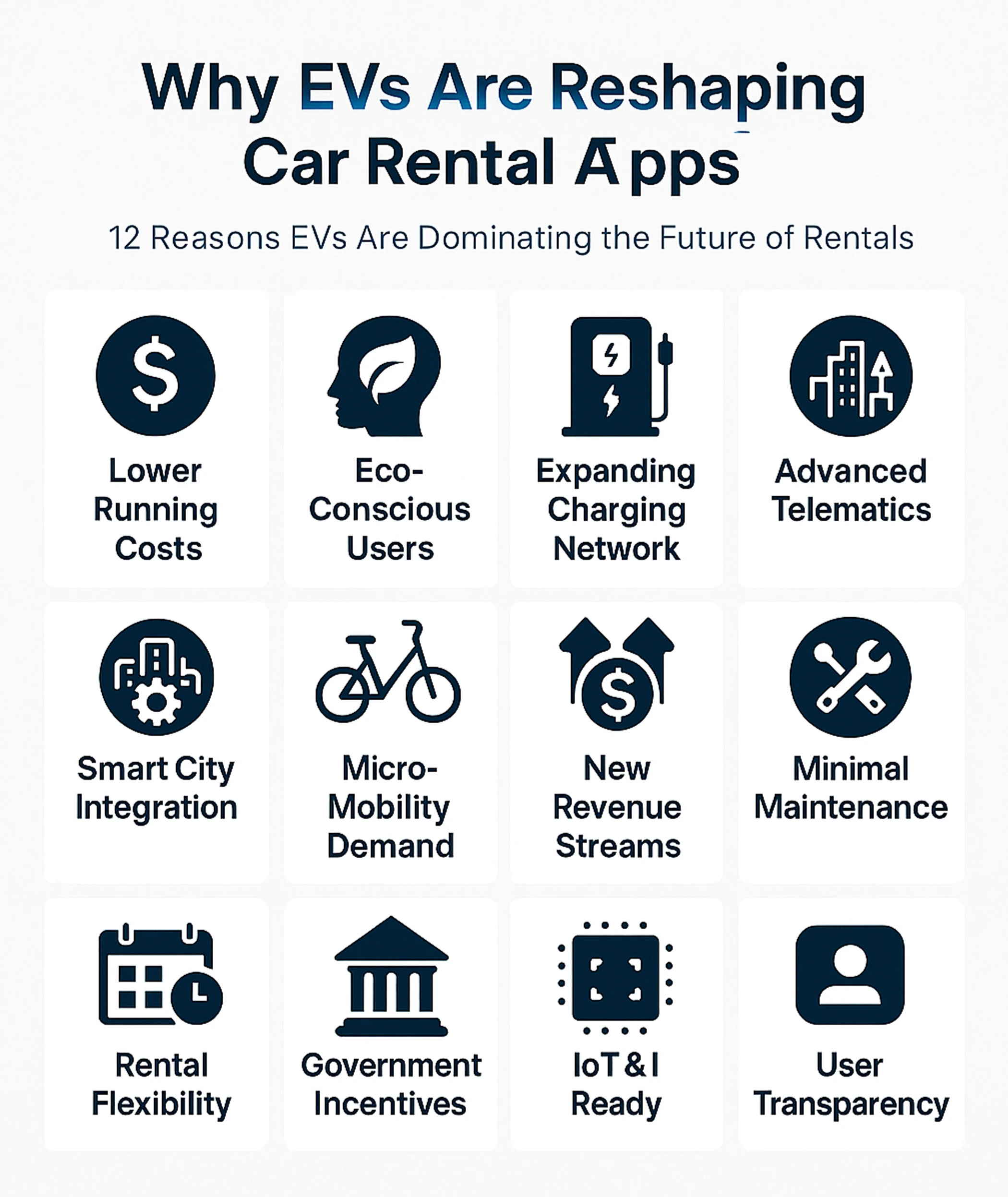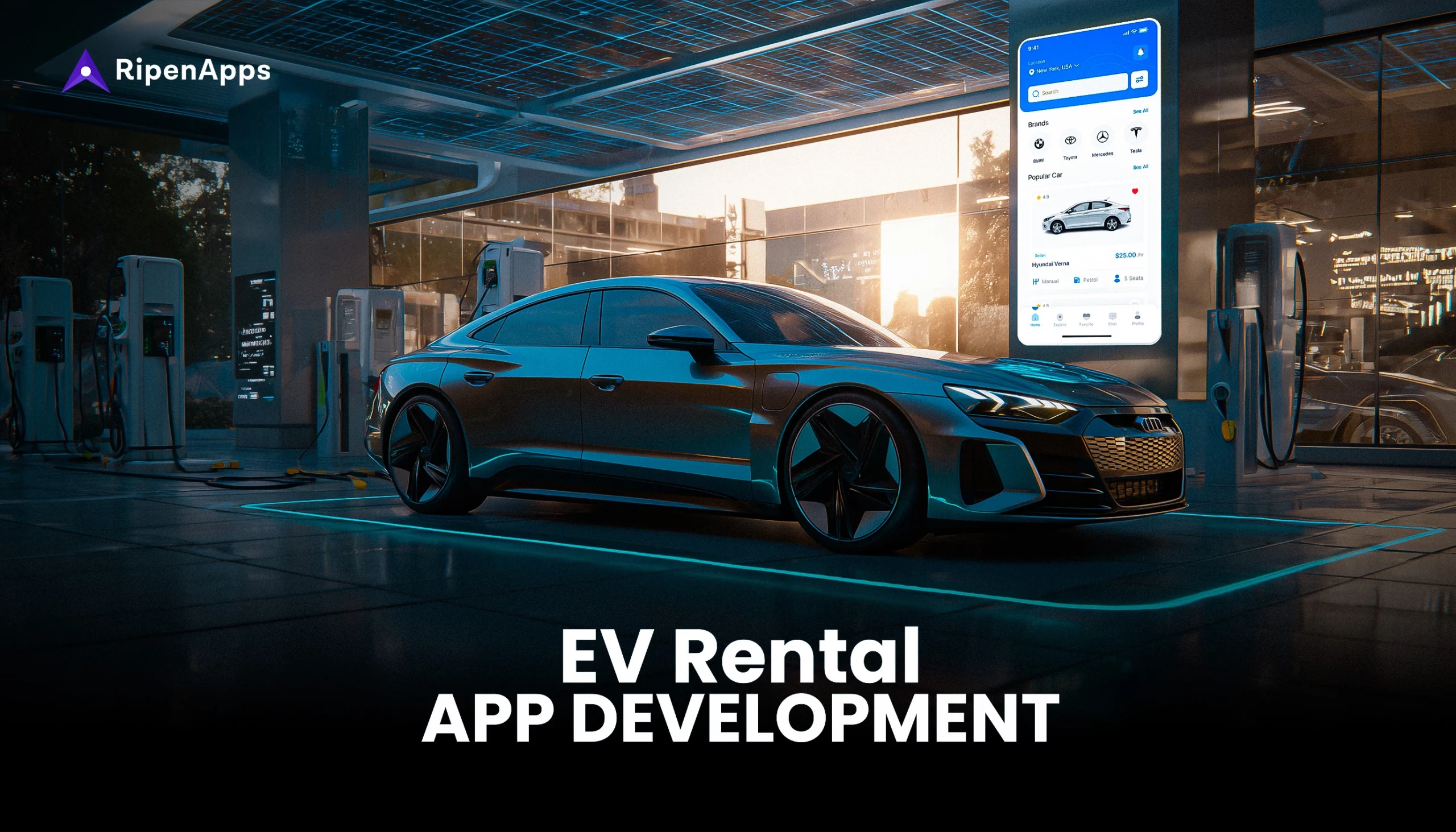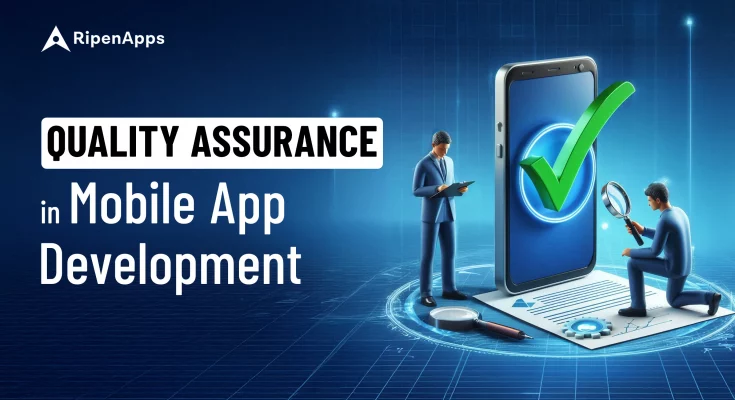It’s 2025. Streets are quieter, and charging stations outnumber gas pumps. And users? They aren’t looking to rent a car, they’re looking to rent the future.
From urban commuters searching for zero-emission zips to eco-conscious travelers ditching diesel dreams, the EV revolution has completely changed the way people move and who profits from it. But here comes a challenge: Traditional car rental models are struggling to adapt. Customers now demand seamless bookings, real-time EV battery tracking, and smart sustainability scores and all from one screen. Thus, if your app doesn’t evolve, your competitor will.
Successfully launching an EV-ready car rental app isn’t about following trends; it’s a tech movement. One that’s user-first, data-driven, and built for tomorrow’s roads. But how do you build a platform that users love, EV manufacturers trust, and investors notice?
If you are an entrepreneur running a rental car business or looking to start an auto-tech startup, this blog will help you discover what exactly the tech stack you need, features users look for, and revenue models that scale. So, stay tuned till the end to enter the world of electric mobility and make your EV car rental app successful in the competitive market.
Table of Contents
From Roads to Revenue — Why EVs Are Reshaping Car Rental Apps?
Electric Vehicles are not only changing what’s on the road, they’re also bringing a seismic change in the way revenue flows in the mobility industry. With rising fuel prices, global climate goals, and tech-savvy users are demanding greener choices. Therefore, EV adoption is no longer optional; it’s inevitable.
Let’s talk numbers:
- According to industry reports, the Global EV Market Size is projected to hit $980 billion by 2028, growing at a 24.5% CAGR.
- Over 65% of car rental users now say they’d prefer EVs if available via app-based services.
- Latest reports show that several countries have already announced bans on petrol/diesel vehicle sales between 2030–2040.
- EVs cost 60% less to maintain than ICE vehicles, translating into higher margins for rental platforms.
Why EVs are Shaping the next-gen Car Rental Platforms?
1. Lower Operational Costs = Higher Profits
EVs reduce fuel and maintenance expenses by up to 60%. Therefore, increasing margins for rental companies. ( Source: NRDC)
2. Eco-Conscious Users Prefer Greener Rides
Over 70% of Gen Z and Millennials prefer brands with a sustainability focus. Thus, EVs fit the bill perfectly.
3. Fast-Charging Infrastructure Is Expanding
With global EV charging stations expected to reach 2.6 million+ by 2030. It showcases that the ecosystem is more user-friendly than ever.
4. EVs Offer Advanced Telematics
Real-time data on battery status, location, usage, and performance improves fleet management and user experience.
5. Smart Cities Are Prioritizing EV Mobility
Governments are pushing policies to integrate EV rental fleets into urban mobility planning and smart traffic systems.
6. Increased Demand for Micro-Mobility
Urban users prefer short, silent, zero-emission trips. That’s why EVs are ideal for city-based rentals and hourly packages.
7. Attracts New Revenue Streams
EVs generate additional income via in-app charging payments, battery health insights, carbon footprint tracking, and advanced features.
8. Simpler Maintenance, Fewer Downtimes
With fewer moving parts, EVs need fewer repairs. Therefore, keeping your fleet alive and earning more often. You can also work closely with a leading MVP development company to validate your idea and gather feedback for regular maintenance.
9. Subscription-Based Rentals Work Better with EVs
Flexible rental models like hourly, daily, or weekend subscriptions become more viable due to EV efficiency and tracking.
10. Eligible for Government Incentives
Get access to subsidies, tax breaks, and startup grants by building EV-first rental solutions.
11. Seamless Integration with IoT & AI
From remote diagnostics to predictive battery analytics, EVs offer a tech-rich layer that traditional car rentals lack.
12. Users Expect Transparency
EVs allow you to show energy consumption, cost-per-mile, and emissions saved, driving better customer trust.
User Insight: Today’s user wants to see battery range, find nearest charging stations, compare emissions saved, and track driving behavior, all within your app. In this case, EVs are not just cars; they are data centers on wheels, sustainability tools for users, and profit engines for businesses. The EV revolution is already on the streets. The question is—is your car rental app built for it?
Choosing the Right Tech Stack: Built to Charge, Not Just Run
The tech stack behind your EV rental app isn’t just a list of tools, but it’s the engine that drives every tap, swipe, and seamless booking. In an ecosystem where users expect instant access, real-time updates, and flawless EV integration, your technology must go beyond functional; it has to be future-ready.
Choosing the right stack means your EV car mobile applications can scale, adapt, and deliver a wow-worthy experience every single time someone rents a car. Here’s the EV-ready tech stack that puts users first:
Frontend Technologies
What users see, touch, and engage with.
- React Native / Flutter – Build cross-platform apps with smooth UI/UX across Android & iOS.
- TypeScript / JavaScript – Add structure, responsiveness, and high interactivity.
- Redux / MobX – For managing real-time states like vehicle availability or battery status.
Backend Technologies
Where the logic, scalability, and real-time data magic happens.
- Node.js / Python (Django) – Lightweight, scalable, and great for handling dynamic data loads.
- GraphQL / REST APIs – Allows real-time vehicle data sync (like battery levels or charging locations).
- Firebase / AWS Amplify – For authentication, cloud storage, and serverless backend support.
Database
The database that remembers everything, from user preferences to vehicle status.
- MongoDB / PostgreSQL – Flexible, scalable databases for handling user profiles, bookings, and EV telematics.
- Redis – For fast caching of vehicle locations and availability.
EV-Specific Integrations
Because EVs bring in unique needs.
- IoT Integration – For real-time vehicle diagnostics, battery status, GPS, and lock/unlock features.
- Charging Station APIs (like ChargePoint, Open Charge Map) – To help users locate and navigate to the nearest charging spot.
Admin & Fleet Dashboard
For managing your EV inventory and gaining control.
- React / Angular Dashboards – For fleet managers to track vehicles, manage users, and analyze revenue.
- Power BI / Tableau – For performance and usage analytics.
Tools to Boost UX
- Stripe / Razorpay – Seamlessly integrate secure payment gateways.
- Firebase Cloud Messaging (FCM) – Real-time push alerts for booking confirmations, charging status, etc.
- Mapbox / Google Maps – Navigation and EV trip planning features.
Read Also: Latest Full Stack Web Development Technologies To Pick For Your Project
What Features Does an EV App Must Include?

Gone are the days when a simple booking screen was enough. In 2025, EV car rental apps must deliver a smart, intuitive, and data-rich experience that matches both the expectations of eco-conscious users and the performance of modern electric vehicles. So, here are some must-have features of car rental applications to stay ahead:
Real-Time Battery & Range Tracking
Users want to know how far they can go. Show live battery percentage, estimated range left, and alerts for low charge. You can seamlessly integrate them all with in-app maps.
EV Charging Station Locator
Make sure to help users find the nearest compatible charging station. Add filter options like plug type, availability, pricing, and fast-charging support for a smoother trip. You might need to avail of electric car rental services to seamlessly integrate such a feature into your app.
Live Vehicle Tracking & Remote Access
This car rental app feature allows users to unlock, locate, and start their vehicle via the app. Add features like remote climate control for extra comfort points.
Smart Route Planning
Use AI or real-time data to suggest routes based on charging points, traffic, terrain, and range. You can also display the estimated charge needed for the trip. A leading mobile app development company in USA can help you figure out how to integrate such features into your app.
Flexible Booking Options
From hourly to daily or weekend rentals, users want flexibility. So, if you want to build a car rental app like Turo, you need to add subscription plans, multi-day packages, or even energy-based billing.
Carbon Footprint & Eco Score
Show users the impact they’re making. Display CO₂ saved per ride, green badges, or gamified eco-points for brand loyalty and environmental pride.
In-App Support & EV Education
Include a knowledge center with EV FAQs, troubleshooting, and video tutorials. You must integrate these car rental app features to add a 24/7 chat for assistance on charging, range anxiety, or app use.
Smart Security & Geofencing
With the help of a trusted car rental app development company in USA, you can integrate advanced anti-theft features like vehicle immobilization, geo-fencing alerts, and speed limit warnings. Thus, making your EV rental fleet smarter and more secure, especially for fleet owners.
Integrated Payments & Wallets
Having secure payment gateways in your app is a crucial part of EV rental car app development. So, let users pay for both rentals and charging within the app. Support UPI, cards, wallets, and even green credits or carbon tokens in the future.
Revenue Tips for 2025: EV Rental Models That Actually Scale
In 2025, profitability does not mean increasing rentals; it’s about building flexible, tech-enabled revenue streams that perfectly align with how users want to move. With electric vehicles entering the competitive market, there’s a massive opportunity to monetize in smarter, cleaner, and more customer-first ways. One of the major reasons is that EV cars are more data-rich and cost-efficient, which opens doors to revenue strategies that go beyond traditional hourly rates. So, here’s how you can scale your EV rental app smartly:
1. Subscription-Based Plans
You can offer flexible weekly or monthly EV rental subscriptions tailored for frequent users. These plans build predictable income, boost user retention, and are perfect for professionals, tourists, or eco-conscious commuters who don’t want to own but want access anytime.
2. Charging-as-a-Service (CaaS)
Try to seamlessly integrate EV charging within your app and allow users to pay for it directly. By partnering with charging networks, you can earn a commission for every session. Therefore, making your app a one-stop platform for both mobility and energy.
3. Dynamic Pricing Model
Top car rental app development companies can help you implement AI-powered pricing that adjusts based on demand, location, time of day, or battery range. This not only maximizes earnings during peak hours but also helps balance fleet availability and improves user experience with fair pricing.
4. Corporate & Fleet Rentals
Don’t forget to target companies looking for sustainable travel solutions. Provide long-term rental packages with custom dashboards and analytics for employee mobility or last-mile delivery. This will unlock high-volume, repeat revenue from B2B clients.
Read Also: On-Demand Car Wash App Development: Scope, Features, Revenue Model
Powering Global Scalability: Building for Multi-City, Multi-Grid Operations
If you want to scale an EV rental app across cities and even countries, you need to develop a feature-rich platform that can handle diverse geographies, utility grids, regulations, and user behaviors. As you expand to new regions, your EV rental app must support multi-city operations with advanced features such as dynamic fleet management, region-specific pricing, localized languages, and charging infrastructure compatibility.
Moreover, it’s also essential to integrate with different electricity grids and charging APIs. Therefore, it ensures accurate battery data, charging costs, and live station availability in every location.
Wrapping Up
Day by day, the demand for seamless, smart, and sustainable rental experiences is skyrocketing. Thus, there are numerous opportunities to successfully launch an EV rental app in 2025. From battery tracking to scalable infrastructure, every advanced feature you integrate, every API you integrate, and every revenue model you adopt should be to achieve one goal, i.e, delivering effortless, eco-friendly mobility that users love.
Whether you’re a startup, a traditional rental company, or a visionary founder aiming to ride the EV wave, now is the perfect time to move from idea to ignition. All you have to do is build with the right tech stack, focus on real user needs, and scale with purpose. The EV future is electric, user-first, and app-driven. So, make sure to build one that leads the charge.
FAQs
1. What is an EV car rental app, and how does it work?
An EV car rental app allows users to rent electric vehicles through a smartphone interface. It connects them with available EVs nearby, shows battery status, charging stations, and enables remote locking/unlocking, all in real-time for a seamless booking experience.
2. Why should I launch a car rental app focused on EVs in 2025?
With the continuous demand for sustainable travel, expanding charging networks, and government incentives, launching an EV rental app can give you a competitive edge in a fast-growing market.
3. How much does it cost to develop an EV rental app?
The car rental app development costs depend on several factors such as app complexity, feature set, and scale. A basic MVP may cost around $30,000–$50,000, while a full-featured multi-city app can go beyond $100,000. It’s advisable to partner with a top-notch mobile app development company in USA to help optimize your budget and build your app accordingly.
4. How can I ensure my EV rental app stands out in a competitive market?
You need to focus on user experience, real-time EV insights, and value-added features like carbon tracking and integrated charging payments. A clean UI, responsive support, and loyalty programs can set your app apart and build long-term user trust.













 India
India USA
USA Australia
Australia Canada
Canada UK
UK UAE
UAE
